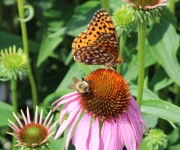Pollination is the process of moving pollen grains between two flowers of the same species. About 75 percent of all flowering plants need help from pollinators and successful pollination results in healthy fruit and fertile seeds.

Honey bees are the top pollinators, but are threatened by many different sources. Considering their declining numbers, we are fortunate there are many other creatures willing to do the work. Moths, butterflies, bees, wasps, birds, bats and small mammals also pollinate.
You can help these nectar-loving creatures survive and multiply by providing clean water and by planting a pollinator garden of flowers and shrubs that will attract them in different seasons. Some flowers are favored more than others because of the quality and quantity of nectar. A pollinator garden consists of plants rich in nectar, like purple coneflowers, bee balm and liatris, or gay feather. Restoring pollinator habitat in fields with hedgerows and wildflower meadows can contribute to more and better fruits and vegetables for farmers.
The Little Nature Museum in Warner has an intriguing display on pollinators and what you can do to help them. Outside of the museum stretches a beautiful pollinator garden that is now in full bloom. Hungry bees, butterflies and wasps are pollinating the flowers every day while gathering nectar.
“We purchased many of these plants from the Merrimack County Conservation District in the past couple of years. The coneflowers came from my home garden, and I grew the common milkweed from seed,” said Barbara Lassonde, the master gardener who tends this garden.
“Monarch butterflies lay their eggs only on milkweed, and because they’re rapidly declining, we want to help them any way we can. I love the Monarchs. They used to be plentiful around here, but in the past several years, I’ve seen only a few,” Lassonde said.
The volunteers at The Little Nature Museum hope you’ll stop by to see the garden and visit the museum at 18 Highlawn Road in Warner, just off Kearsarge Mountain Road.
“Visitors are always amazed at how much they learn here, and our pollinator display is only a tiny portion of all the fascinating things we have,” Lassonde said. “Because we’re an interactive, hands-on nature center, it’s a great place for kids and adults.
More information about the museum can be found at: littlenaturemuseum.org.